
Beetles are insects that form the order Coleoptera, in the superorder Holometabola. Their front pair of wings are hardened into wing-cases, elytra, distinguishing them from most other insects. The Coleoptera, with about 400,000 described species, is the largest of all orders, constituting almost 40% of described insects and 25% of all known animal species; new species are discovered frequently, with estimates suggesting that there are between 0.9 and 2.1 million total species. Found in almost every habitat except the sea and the polar regions, they interact with their ecosystems in several ways: beetles often feed on plants and fungi, break down animal and plant debris, and eat other invertebrates. Some species are serious agricultural pests, such as the Colorado potato beetle, while others such as Coccinellidae eat aphids, scale insects, thrips, and other plant-sucking insects that damage crops.

Lundy is an English island in the Bristol Channel. It forms part of the district of Torridge in the county of Devon.
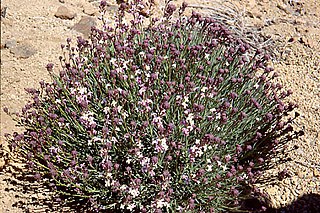
Erysimum, or wallflower, is a genus of flowering plants in the cabbage family, Brassicaceae. It includes more than 150 species, both popular garden plants and many wild forms. The genus Cheiranthus is sometimes included here in whole or in part. Erysimum has since the early 21st century been ascribed to a monogeneric cruciferous tribe, Erysimeae, characterised by sessile, stellate (star-shaped) and/or malpighiaceous (two-sided) trichomes, yellow to orange flowers and multiseeded siliques.

The insects of the beetle family Chrysomelidae are commonly known as leaf beetles, and include over 37,000 species in more than 2,500 genera, making up one of the largest and most commonly encountered of all beetle families. Numerous subfamilies are recognized, but the precise taxonomy and systematics are likely to change with ongoing research.

The Haliplidae are a family of water beetles that swim using an alternating motion of the legs. They are therefore clumsy in water, and prefer to get around by crawling. The family consists of about 200 species in 5 genera, distributed wherever there is freshwater habitat; it is the only extant member of superfamily Haliploidea. They are also known as crawling water beetles or haliplids.
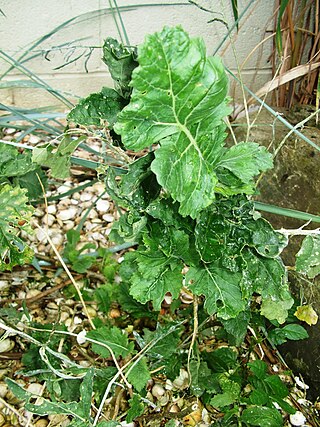
Coincya wrightii, known as Lundy cabbage, is a species of primitive brassicoid, endemic to the island of Lundy off the southwestern coast of England, where it is sufficiently isolated to have formed its own species, with its endemic insect pollinators. Coincya wrightii grows natively only on the eastern cliffs and slopes of the island and nowhere else in the world and is a protected species. It reaches up to a metre in height and with its yellow flowers it looks a little similar to oil seed rape. Although it is a member of the cabbage family, it tastes unpleasant – it has been described as "triple-distilled essence of Brussels sprout".

The flea beetle is a small, jumping beetle of the leaf beetle family (Chrysomelidae), that makes up the tribe Alticini which is part of the subfamily Galerucinae. Historically the flea beetles were classified as their own subfamily.
The Arran whitebeams are species of whitebeam endemic to the island of Arran, Ayrshire, Scotland.
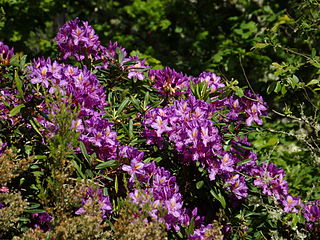
Rhododendron ponticum, called common rhododendron or pontic rhododendron, is a species of Rhododendron native to the Iberian Peninsula in southwest Europe and the Caucasus region in northern West Asia.

Coincya is a genus of flowering plant that belongs to the family Brassicaceae. Three species of the plant are endemic to the British Isles, these being Coincya wrightii, Coincya cheiranthos (nokkasinapit) and Coincya monensis, which has two subspecies, C. monensis subsp. monensis and C. monensis subsp. recurvata. Another four species are endangered and endemic to the south-central Iberian peninsula.

Coincya monensis subsp. monensis, the Isle of Man cabbage, is a species of plant in the family Brassicaceae that is found in coastal habitats on the west of the island of Great Britain and around the coasts of the Isle of Man.

Diplotaxis tenuifolia is a species of flowering plant in the mustard family known by the common name perennial wall-rocket. It is native to Europe and western Asia, where it grows on disturbed ground and roadsides, and it can now be found throughout much of the temperate world where it has naturalized. In recent years it has increasingly been cultivated to produce salad leaves, which are marketed as wild rocket in Britain or arugula in the US. It is easily confused with garden rocket, which has similar uses.

Coccinella leonina, common name orange-spotted ladybird, is a species of ladybird native to New Zealand. It is black with orange spots. A predator species, it is present in a variety of habitats.
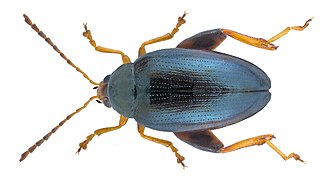
Psylliodes chrysocephala or Psylliodes chrysocephalus, commonly known as the cabbage-stem flea beetle, is a species of leaf beetle situated in the subfamily Galerucinae and the tribe Alticini.

Ceutorhynchus obstrictus, the cabbage seedpod weevil, is a species of snout beetles or true weevils which is widespread in Europe and lives on several types of crucifers. The adult weevils feed on the leaves, but breed in the seedpods, where the larvae destroy the seeds. It can be a harmful pest on crops like rapeseed/canola, cabbage and relatives or Brassica rapa.
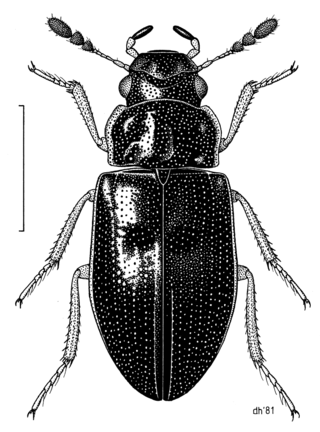
Horelophus walkeri is a small water scavenger beetle that is endemic to New Zealand. It is found in the South Island in the West Coast, Nelson, Buller and Marlborough regions. The preferred habitat of this species are the moss and crevices within the splash zone of waterfalls sourced from fast flowing, clear, cool waterways. The larvae of this species are carnivorous while the adults are herbivores or scavengers. In 2012 the Department of Conservation classified this beetle as Nationally Endangered.
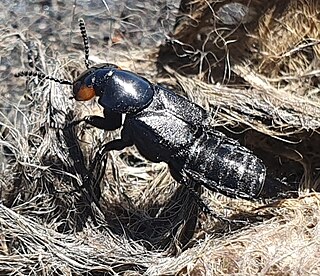
Creophilus oculatus or devil's coach horse is a species of large carrion-feeding rove beetle endemic to New Zealand.

Ophraella nuda, the naked flea beetle, is a species of skeletonizing leaf beetle in the family Chrysomelidae.

















